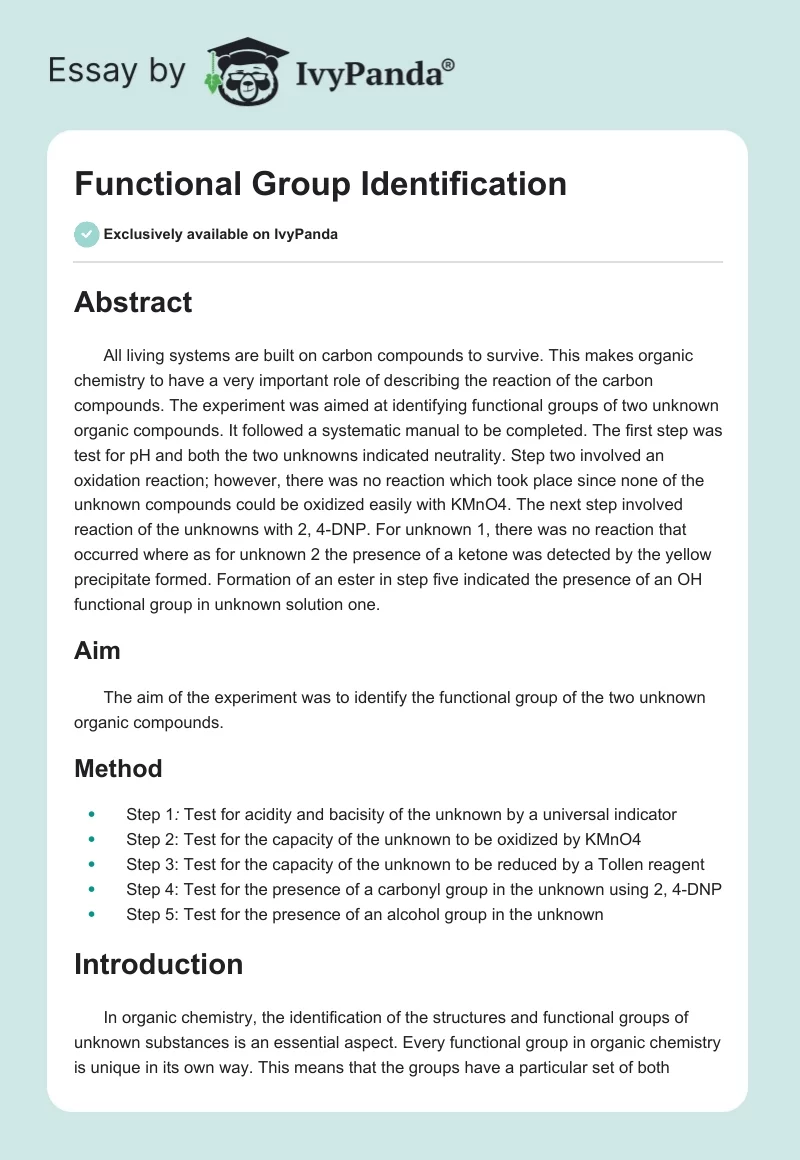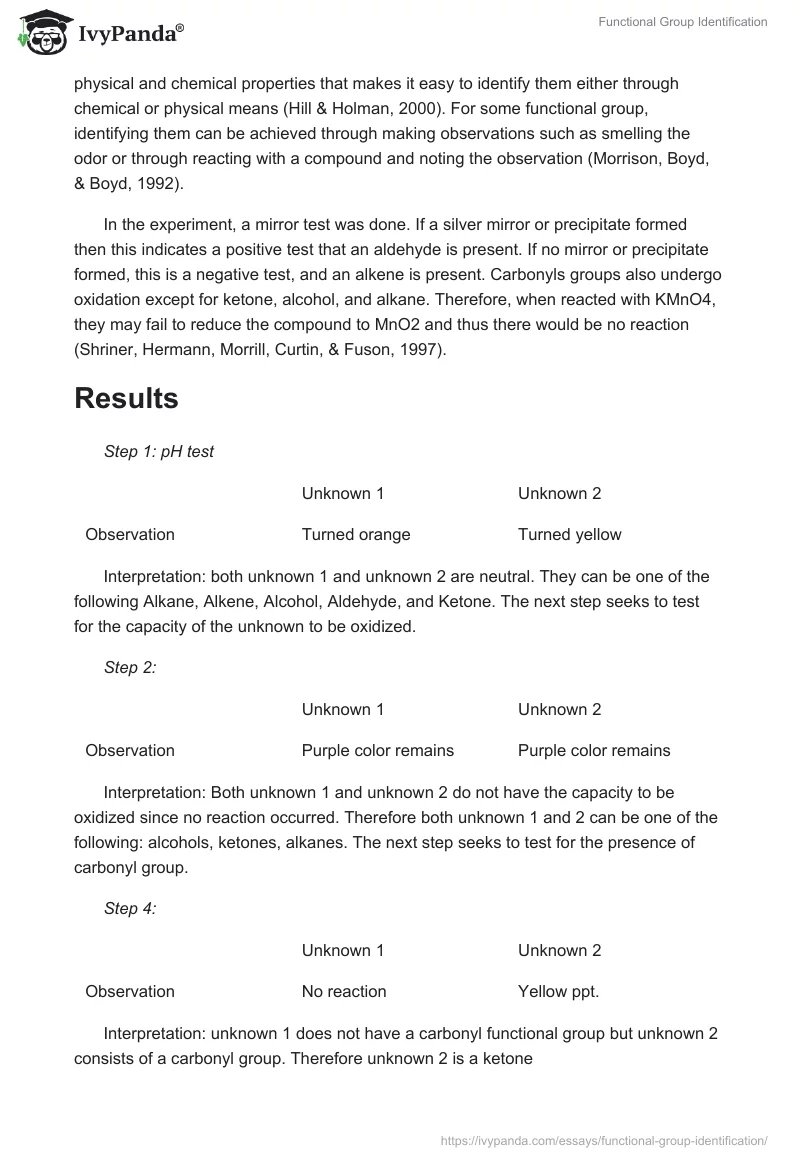Abstract
All living systems are built on carbon compounds to survive. This makes organic chemistry to have a very important role of describing the reaction of the carbon compounds. The experiment was aimed at identifying functional groups of two unknown organic compounds. It followed a systematic manual to be completed. The first step was test for pH and both the two unknowns indicated neutrality. Step two involved an oxidation reaction; however, there was no reaction which took place since none of the unknown compounds could be oxidized easily with KMnO4. The next step involved reaction of the unknowns with 2, 4-DNP. For unknown 1, there was no reaction that occurred where as for unknown 2 the presence of a ketone was detected by the yellow precipitate formed. Formation of an ester in step five indicated the presence of an OH functional group in unknown solution one.
Aim
The aim of the experiment was to identify the functional group of the two unknown organic compounds.
Method
- Step 1: Test for acidity and bacisity of the unknown by a universal indicator
- Step 2: Test for the capacity of the unknown to be oxidized by KMnO4
- Step 3: Test for the capacity of the unknown to be reduced by a Tollen reagent
- Step 4: Test for the presence of a carbonyl group in the unknown using 2, 4-DNP
- Step 5: Test for the presence of an alcohol group in the unknown
Introduction
In organic chemistry, the identification of the structures and functional groups of unknown substances is an essential aspect. Every functional group in organic chemistry is unique in its own way. This means that the groups have a particular set of both physical and chemical properties that makes it easy to identify them either through chemical or physical means (Hill & Holman, 2000). For some functional group, identifying them can be achieved through making observations such as smelling the odor or through reacting with a compound and noting the observation (Morrison, Boyd, & Boyd, 1992).
In the experiment, a mirror test was done. If a silver mirror or precipitate formed then this indicates a positive test that an aldehyde is present. If no mirror or precipitate formed, this is a negative test, and an alkene is present. Carbonyls groups also undergo oxidation except for ketone, alcohol, and alkane. Therefore, when reacted with KMnO4, they may fail to reduce the compound to MnO2 and thus there would be no reaction (Shriner, Hermann, Morrill, Curtin, & Fuson, 1997).
Results
Step 1: pH test
Interpretation: both unknown 1 and unknown 2 are neutral. They can be one of the following Alkane, Alkene, Alcohol, Aldehyde, and Ketone. The next step seeks to test for the capacity of the unknown to be oxidized.
Step 2:
Interpretation: Both unknown 1 and unknown 2 do not have the capacity to be oxidized since no reaction occurred. Therefore both unknown 1 and 2 can be one of the following: alcohols, ketones, alkanes. The next step seeks to test for the presence of carbonyl group.
Step 4:
Interpretation: unknown 1 does not have a carbonyl functional group but unknown 2 consists of a carbonyl group. Therefore unknown 2 is a ketone
Interpretation: unknown 1 is an alcohol since it reacted with an acid to produce an ester which has a sweet fragrance.
Discussion
In step one a universal indicator was used to test for the pH of the two unknowns. If the two unknown solutions were acidic, they would turn the universal indicator red. If they were basic the universal indicator would turn blue. Since both unknown 1 and unknown 2 caused the universal indicator to turn yellow, they had a neutral pH of 7. This means that they could either be alkenes, alcohols, aldehydes, alkanes, and ketones. In step 2, both unknown 1 and unknown 2 did not react with KMnO4. This means that did not have a capacity to be oxidized (Willighagen & Brändle, 2011).
If they were oxidized, KMnO4 could be reduced to MnO2 which is dark brown in color. In step four, unknown 1 did not react with 2, 4-DNP but unknown 2 reacted. 2, 4-DNP is used to test for the presence of carbonyl group, including ketones and aldehydes. Unknown 1 did not react since it did not contain a carbonyl group. Step five was testing the presence of alcohol group since alcohols react with acids to give esters. Unknown 1 was alcohol because the end product from the reaction was a substance with a sweet fragrance (Kakati & Sarma, 2011).
Questions
Question 1
Unknown 1 is an alcohol and unknown 2 is a ketone. Unknown one is an alcohol because of the results of step five. Alcohols react with carboxylic acids to produce esters which have sweet smell. Ketones are known to react with 2, 4-dinitrophenylhydrazine to produce a bright yellow precipitate (Allen, 1998).
In step one, unknown 1 turned orange meaning that the compound had pH more than 7 and thus ruling out chances of unknown 1 being a carboxylic acid or an amine. In step two, the purple color persisted and therefore no reaction occurred. Possible compounds could be alcohol, alkane or ketone. In step four, there was no reaction ruling out ketone since it reacts with 2, 4-DNP (Brady & Elsmie, 1999). In step 5 there was formation of a liquid with a perfumed smell indicating presence of an ester (Pikens, 2000). This makes unknown 1 to be an alcohol.
In step one unknown 2 turned yellow meaning that the unknown compound had a pH of more than 7. This therefore ruled out possibility of unknown two being a carboxylic acid or an amine. Moving on to step two, the purple color of KMnO4 persisted indicating that there was no reaction thus ruling out chances of unknown two being aldehyde or alkene. In the step the reaction between unknown two and 2, 4-DNP gives a yellow solution. Since aldehyde was the other option that reacts with 2, 4-DNP but was ruled out, unknown two therefore is a ketone (Allen, 1998).
Question 2
Testing for acidity and basicity of the unknown liquid using a universal indicator shows that it has a neutral pH of 7. This means that the liquid can be an alkane, alkene, alcohol, aldehyde or a ketone. Carboxylic acids are acidic in nature and when tested with a universal indicator, they turn red. Amines on the other hand are basic in nature and they make the universal indicator to turn blue. KMnO4 is an oxidizing agent and mainly used to test for the capacity of the unknown liquid to be oxidized. KMnO4 is usually purple in color. If there is no reaction between KMnO4 and carboxyl group, it means the carboxyl does not have a capacity to be oxidized. Therefore, since the purple color remained, the unknown liquid did not react with KMnO4. Alcohols, alkanes, and ketones are the only compounds which are not easily oxidized. Both aldehydes and ketones give a yellow precipitate when reacted with 2, 4-DNP. But since aldehyde was ruled out in the second step, the unknown liquid is a ketone.
Question 3
Fehling reagent consist of copper (II) ions which are complex in alkaline solutions with titrate ions. The Fehling reagents react with aldehyde. Clinically, they can be used to detect the presence of reducing sugars. Tollen reagents which is used for mirror test is also clinically applied in detection of reducing sugars. One of the most common commercially used derivatives of carboxylic acids is esters. Esters have a nice fragrance that can be used to give soaps and detergents, and solvents the nice smell.
Question 4
The simple color tests are specifically useful in forensic science and testing athletes for use of strength enhancing drugs (Shriner, Hermann, Morrill, Curtin, & Fuson, 1997). Organic substances in the drugs can be detected by testing the urine of athletes for the presence of certain functional groups. Forensic chemists can run the tests to determine composition of certain materials in order to predict the source. The simple color tests are among the techniques used for analytical chemistry (Roberts & Caserio, 1994).
References
Allen, C. F. (1998). 2,4-Dinitrophenylhydrazine. Organic synthesis, Vol. 2: 228.
Brady, O. L., & Elsmie, G. V. (1999). The use of 2:4-dinitrophenylhydrazine as a reagent for aldehydes and ketones. Analyst, 51 (599): 77–78.
Hill, G., & Holman, J. (2000). Chemistry in Context (4th ed.). New York: John Willey and sons.
Kakati, D., & Sarma, J. C. (2011). free synthesis of 1,3-diphenylpropenones. Chemistry Central Journal, 5:8.
Morrison, R. T., Boyd, R. N., & Boyd, R. K. (1992). Organic Chemistry. Benjamin Cummings.
Pikens, D. (2000). Intergrated experimental chemistry. New York: Pearson.
Roberts, J. D., & Caserio, M. C. (1994). Basic Principles of Organic Chemistry. W. A. Benjamin, Inc.
Shriner, R., Hermann, C., Morrill, T., Curtin, D., & Fuson, R. (1997). The Systematic Identification of Organic Compounds. New York: John Wiley & Sons.
Willighagen, E. L., & Brändle, M. P. (2011). Resource description framework technologies in chemistry. Journal of Cheminformatics, 3:15.


